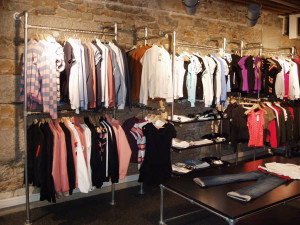This summer I am taking an ethics class and was assigned, as in all my graduate classes, a research paper. For this class, I chose to deviate from my normal topic range and tackle the idea of sweatshops and cheap labor. (ok, the topic isn’t that far from the normal range of issues I am passionate about) I have to admit, I would be the first to say I do not agree with sweatshops and I am semi-careful about where I shop, but I still love to shop and love a bargain. In my research for the paper, I came across a book- Overdressed: The High Cost of Cheap Fashion. Since I have to write 20 pages on the topic, I figured I would read it and grabbed a handful of other books on sweatshops, globalization, and cheap goods.
Sadly, the research paints a very bleak picture. I closed Overdressed and was ready to give up. It seems that no one is producing high-quality goods made with fair labor practices. At least no one anywhere close to my budget. The economic downturn put a crunch on our wallets and the demand for cheap goods continued to rise. So much so over the past ten years, major corporations have completely changed their production models. Gone are the days of seasonal shopping. Today the biggest companies race to put new clothing on the racks every 2-3 weeks. When you are talking about clothing that is made in any number of countries around the world and shipped to the US, you are talking about a massive undertaking. Worker’s rights are the farthest thing from anyone’s mind when you have tight deadlines and demands for cheap products. After all, when you buy a shirt for under $20, the company still wants to make a profit.
And as corporations have shifted, so has culture. No longer do we purchase items intending on keeping them for years, but rather to wear to a specific event or occasion. We can be content to buy a dress to wear once as long as the price is right. Not only do we do it with clothes, but we are always upgrading to the latest, greatest electronic device despite the fact the ones we have work just fine. It is an easy road to take from a throwaway phone or shirt to a throwaway child or garment maker. Cheap clothes depend on cheap labor. Cheap labor depends on factories willing to cut corners and deny workers’ rights.
The problem is.. EVERYONE is doing it. And we are feeding it by our shopping habits and desires to consume more and more. The sad reality is, unless consumers start to demand higher quality goods and show they are willing to pay a little more for classic, well-made pieces, there is little hope for change. Regardless, a ripple starts with one drop so I am committed to changing my habits. I have a closet-full of clothes and more than enough to last me a long time. My research has inspired me to attempt to learn how to sew and save my money to purchase classic, well-made pieces. I cannot complain about a system I am helping to perpetuate. Instead, I am going to adjust my personal habits and get involved as much as I can. And next time, I may pick a slightly less convicting research paper topic. 🙂


3 Comments
Quincy Zikmund
This is really good. I was just thinking about this over the weekend! For the first time in a few years I recently bought some new pants and over the weekend some new shirts. I was excited because I actually found some good deals (Im picky and I tend to have expensive taste), but looking at the tags and where the shirts were made caused me to think about the sweatshops and how hard it is to really buy completely cruelty free clothing. It’s not impossible by any means. It just takes mindfulness and understanding that quality is more important than quantity. I think most people could afford pricier clothing items made under fair worker treatment if everyone could just be content with fewer items. We’d probably all ultimately spend the same amount of money. Most likely even less in the long run.
Amanda
I agree! I am also reading a book called Where am I wearing? It’s been interesting to see all the countries represented in my waredrobe. Definitely going to think twice about all the clothes I buy!!
Greg
And some of those same people who buy items to wear once or twice and then discard them probably drive a Prius and recycle and think they are practicing being “green”.
If you want to be “green” and leave a smaller carbon footprint, “buy once, cry once”. Pay for high quality, maintain it and keep it as long as you can. If people understood how much energy is consumed in bringing a product to the consumer, they would quickly realize that they are not being very environmentally conscience.
Look at people who buy bamboo flooring because it’s sustainable. Do they realize the carbon footprint that is created by harvesting it, putting it in a container ship and sailing it halfway around the globe, putting it in a truck and trucking it across our country to have it at the store for them?
It would be much “greener” to buy a regionally harvested hardwood!